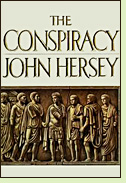The Conspiracy
by John Hersey
Reviewed by David Maclaine

The moral landscape of Hersey's 1972 novel The Conspiracy, set in Emperor Nero's Rome, resembles that of a recent and justly acclaimed foreign film, The Lives of Others, in which East German secret police monitor the daily life of a writer who has come under suspicion. Hersey's novel is set in much the same mental world of spymasters, relentless in their efforts to uncover "subversion," boring in upon artists who would prefer to keep their heads down in a world dominated by tyranny. Here, too, artists discover that in the long run neutrality is not an option. In this case, the inquisition's drivers are Tigellinus, head of Nero's Praetorian Guard, and his not-quite-so-enthusiastic colleague Paenus, Tribune of Secret Police. Their targets are an assortment of Roman nobles and two of the most prominent writers of the day: the veteran playwright and philosopher Seneca, Nero's former tutor, and the younger poet Lucan, who chafes at the idea that political caution may require the sacrifice of his artistic ideals.
Hersey, a Pulitzer Prize winner, was up to the task of constructing a gripping novel entirely from letters and other documents exchanged by the spymasters or intercepted from their victims. His novel skillfully depicts an assortment of historical figures, including the emperor himself. If you've read Quo Vadis you'll recognize a slightly different view of an infamous party around the lake in Nero's garden. These snapshots of Roman life are interwoven with issues of universal importance. What is the responsibility of an artist in a world in which unchecked power has usurped old traditions and tramples the rule of law? That question is tossed back and forth in the pages of The Conspiracy. Hersey's characters ponder whether a pervasive system of secret surveillance, designed to prevent dangerous plots, may not create the very conspiracies it sets out to detect. It was an apt question when the novel was written, during Nixon's first term, and is even more urgent today. (1972, 274 pages)
More about The Conspiracy at Powell's Books or Amazon.comThe Conspiracy appears on the list of The 50 Best Historical Novels for a Survey of Ancient Roman History
Other novels set during the reign of Nero:
Quo Vadis by Henryk K. Sienkiewicz (1896), about the conflicts between Christians and the pagan Romans in the time of Nero. See review or more info at Powell's Books
Nero by David Wishart (1996), about Nero from the perspective of his "Advisor on Taste." More info
Nero by Frank Castle (1961), cover copy: "The throbbing story of the mad Caesar whose lust for flesh and blood wrought a reign of violence unequaled in history." More info
Nonfiction about Nero:
The Twelve Caesars by Suetonius (circa 121 A.D.), a gossipy and very readable account of the twelve rulers of Rome from Julius Caesar to Domitian, including Nero. More info
Nero by Edward Champlin (2003). More info
Nero by Michael Grant (1989). More info
At the Movies:
Quo Vadis
Online:
Nero at PBS.org
Back to Novels of Ancient History
Back to Directory of Book Reviews